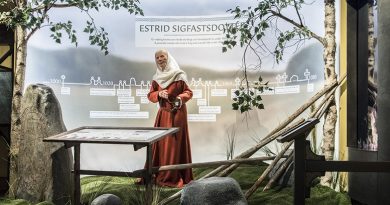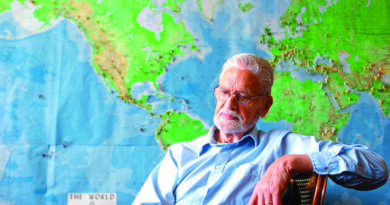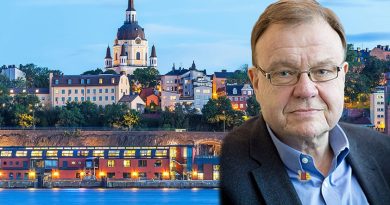The Busy Life of an Honorary Consul General of Sweden
We are pleased to introduce Barbro Osher, Honorary Consul General of Sweden in San Francisco. She chairs The Bernard Osher Foundation and is president of The Barbro Osher Pro Suecia Foundation. She is the founder of the Swedish Women’s Educational Association (SWEA) chapter in San Francisco. She also serves on the boards of the University of California (Berkeley) Foundation and the American-Scandinavian Foundation.
We had an initial interview warm-up by talking about Barbro’s upbringing and career. “My family moved around Sweden quite a bit and we all became bilingual – so-called ‘proper’ Swedish at home and the applicable dialect with local buddies. I graduated from highschool in Motala during the golden age of Swedish education and went on to the University of Stockholm for a Masters, with the hopes of being admitted to the Foreign Ministry. The CV ought to include a study visit to the US, so I applied for scholarship from The Experiment in International Living. 10 Swedes were handpicked in 1962, sent by a student ship to New York and then Washington DC before being distributed to hosts in different parts of the country!”
Barbro ended up in Kennebunkport, Maine, where she by chance met her present husband, businessman and philanthropist Bernard Osher. They were married 18 years later. She did NOT apply to the Foreign Ministry, but accepted the task as honorary Consul General of Sweden in Los Angeles in 1995, followed by San Francisco from 1999 onwards.
As for the work as Honorary Consul General, Barbro offered the following explanation. “I have excellent staff (women only) who take care of the day-to-day consular matters, which is the core of our mandate. We also do a lot of promotional work as well as planning and executing visits by parliamentary groups, governmental officials and other dignitaries. Presently I would say that we have a lot of focus on combined Nordic views and collaboration. Being ‘honorary’ in essence means that I am unpaid. You have a position but no profession.”
In addition to being the Chairperson of the Bernard Osher Foundation, Barbro is the President of her own Barbro Osher Pro Suecia Foundation. “I realized I could do more substantial work for Sweden and the Nordic countries within the parameters of my own Pro Suecia Foundation. It supports areas such as higher education and cultural institutions and programs both in the U.S. and in Sweden.”
Barbro estimates the size of the Swedish and Swedish-American communities in the Bay Area to be between 5,000 and 10,000 individuals, but the numbers fluctuate. “During Election time in Sweden we open as a poll station and can in some ways measure a sizeable increase. The same is true when Swedes renew their passports – a service the Swedish Embassy provides to Swedish citizens. The numbers are the same for Swedish-Americans in the area. Possibly 100,000 Americans of Swedish origin live in California, but that is an unverified number.
On the subject of preserving one’s Swedishness, Barbro explained: “That is something I have been doing persistently and professionally since I first arrived in this country. I missed my life in Sweden: my daughter, my family, my friends, my colleagues, my job and nature. My language! I still do! I would say that we all feel a deep connection with our Swedish past, also in the Swedish-American community.”
The San Francisco chapter of Swedish Women’s Educational Association (SWEA) was started by Barbro in 1982. Swedish sisterhood is special and she wanted to recreate it locally. SWEA SF has been very successful and is globally one of the largest chapters. It organizes a magnificent Christmas Fair every year with Lucia pageant of course, visited by over 3.000 people.
San Francisco is proud to have a Swedish American Hall built in 1907, now a Historic Landmark, in an area that used to be inhabited by Scandinavians. This is still a gathering place for Swedish and Swedish-American activities. Swedish midsummer has been celebrated in the Bay Area since 1894 and is still going strong. Sveadal, for instance, a Swedish recreational village south of San Francisco, gathers thousands for their annual Midsummer celebration with parade, maypole, “Midsummer Queen”, dancing, food and drinks.
During 17 years Barbro was owner and publisher of the venerable Swedish-American newspaper Vestkusten, established in 1886. “I wanted to keep that paper alive as Vestkusten was important for the Bay Area and the West Coast. It was owned by Karin Persson. A fundraising campaign was held every year to keep the paper afloat. She had absolutely no pretentions and no demands on material goods. She really ran this paper for a long time on a shoestring – an incredible achievement! But she could not outrun new technology. As she aged, I stepped in, bought and ran the bi-lingual paper from 1991 to 2007 – although not by myself. I had great professional help!” Barbro and her team marketed the paper all over the West Coast, but the costs remained bigger than the income. The timely question arose: should they go digital. In the end Barbro donated the paper to the Nordstjernan newspaper. Vestkusten disappeared for good.

We asked Barbro how has America changed since her first arrival in 1962. Her reply: “Those were the Kennedy years and change was in the air. The women’s movement began to take shape, and there were soul-searching discussions and actions against discrimination and racism. The United States was a country that was finally opening up to the world in more ways than one. Since then we have been through wars, AIDs epidemics, mass murders, impeachment processes, economic down turns, national disasters, 9/11, Metoo… Presently the formerly civilized tone in the public discourse has disappeared – or maybe just taken a break? I would say that California and the whole West Coast are at the forefront not only in technology but also by leading the way towards more inclusiveness, fairness, insight, and the awareness of climate change.”
We went on to discuss the future development of political, cultural and trade relationships between Sweden and the United States. “I would like to address that as a Nordic issue rather than strictly Swedish. We Nordics are more alike the further away we are from home. Sure, there are differences, but there is also a lot of samsyn (shared view). Basically, we take a similar view on civilized society as concerns inclusiveness, fairness, social welfare, and climate change. We all work for the common good. We believe Government is responsible and caring for the citizens, whereas here, Government is always looked upon with great suspicion. That is one of the big dividing lines between the Nordic countries and America. If together we take the Nordic view, I think we can achieve quite a lot as role models, even for the US.”
But do Americans even know who we are? “If they know anything at all, they usually have a positive view of the Nordic countries, including Sweden,” says Barbro. “Gone are the misconceptions of the four S’s: Socialism, Sex, Suicide and Supertaxes. At this moment Sweden is attracting a lot of positive publicity thanks to Greta Thunberg. She is remarkable!”
When asked about her family, Barbro concluded: “My present husband and I have no children, but I have a fabulous daughter from my first Swedish marriage. She is an MD in Denmark, has a practice as a GP outside of Copenhagen, is married to a Dane, and has three boys. Her grandmother was Norwegian, so you can imagine why I am working in the Nordic way!”
What is the next challenge in Barbro’s busy life? “My goal before retiring is to get all the Nordics together in Northern California, including cohabitation for representation, and building a strong Nordic presence at the universities, the business communities and the cultural institutions.”
Interviewed by Peter Berlin
First published March 15, 2020






